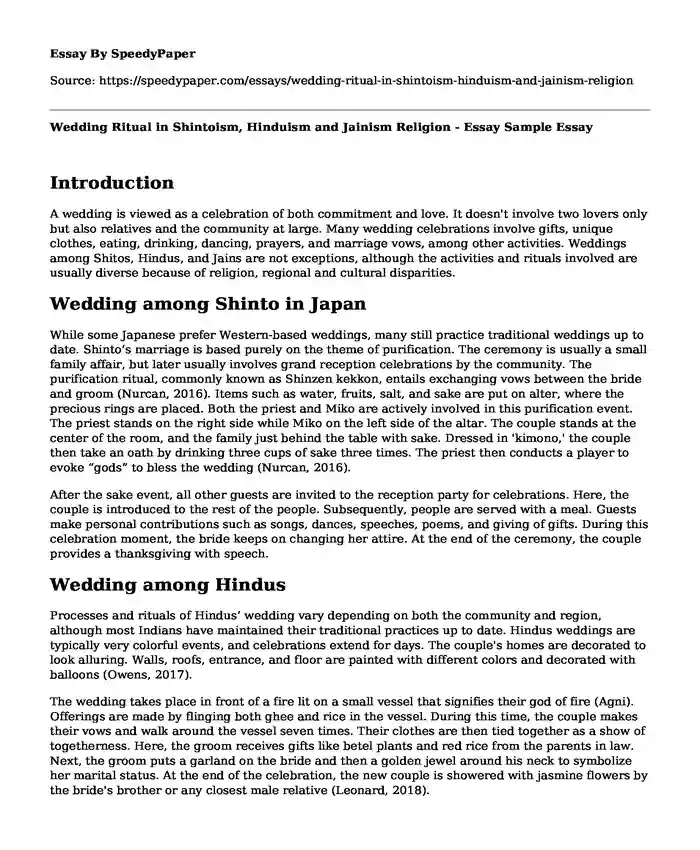Introduction
A wedding is viewed as a celebration of both commitment and love. It doesn't involve two lovers only but also relatives and the community at large. Many wedding celebrations involve gifts, unique clothes, eating, drinking, dancing, prayers, and marriage vows, among other activities. Weddings among Shitos, Hindus, and Jains are not exceptions, although the activities and rituals involved are usually diverse because of religion, regional and cultural disparities.
Wedding among Shinto in Japan
While some Japanese prefer Western-based weddings, many still practice traditional weddings up to date. Shinto’s marriage is based purely on the theme of purification. The ceremony is usually a small family affair, but later usually involves grand reception celebrations by the community. The purification ritual, commonly known as Shinzen kekkon, entails exchanging vows between the bride and groom (Nurcan, 2016). Items such as water, fruits, salt, and sake are put on alter, where the precious rings are placed. Both the priest and Miko are actively involved in this purification event. The priest stands on the right side while Miko on the left side of the altar. The couple stands at the center of the room, and the family just behind the table with sake. Dressed in 'kimono,' the couple then take an oath by drinking three cups of sake three times. The priest then conducts a player to evoke “gods” to bless the wedding (Nurcan, 2016).
After the sake event, all other guests are invited to the reception party for celebrations. Here, the couple is introduced to the rest of the people. Subsequently, people are served with a meal. Guests make personal contributions such as songs, dances, speeches, poems, and giving of gifts. During this celebration moment, the bride keeps on changing her attire. At the end of the ceremony, the couple provides a thanksgiving with speech.
Wedding among Hindus
Processes and rituals of Hindus’ wedding vary depending on both the community and region, although most Indians have maintained their traditional practices up to date. Hindus weddings are typically very colorful events, and celebrations extend for days. The couple's homes are decorated to look alluring. Walls, roofs, entrance, and floor are painted with different colors and decorated with balloons (Owens, 2017).
The wedding takes place in front of a fire lit on a small vessel that signifies their god of fire (Agni). Offerings are made by flinging both ghee and rice in the vessel. During this time, the couple makes their vows and walk around the vessel seven times. Their clothes are then tied together as a show of togetherness. Here, the groom receives gifts like betel plants and red rice from the parents in law. Next, the groom puts a garland on the bride and then a golden jewel around his neck to symbolize her marital status. At the end of the celebration, the new couple is showered with jasmine flowers by the bride's brother or any closest male relative (Leonard, 2018).
Wedding in Jainism Religion
Jainism religion is widely practiced in India. Jains’ wedding is usually simple unlike in the other two religions discussed above. Their wedding is based on both sanctity and purity, and involves several elaborate rituals under strict guidance of Vivah Vidhi (Flügel, 2012). Early in the morning, the bride’s hands, feet and face is applied turmeric in a ritual commonly known as Tel Baan and Haldi. This ritual is followed by Guar Pooja ritual that involves relatives’ blessing to the bride and then gifted silvery jewelry. In the evening, the groom arrives at the venue with his relatives. They are welcomed with a traditional arrti ceremony. Now, the kanyavaran ceremony that ushers the start of the function is held. During this event, the bride's parents give one rupee, rice, and twenty-five paisa on her right hand, and she provides the same to the groom. Consequently, the bride and grooms take the seven vows while moving around the fire in a clockwise direction. Once this is activity is done, the couple is declared wife and husband (Flügel, 2012).
References
Flügel, P. (2012). Jainism. Encyclopedia of Global Studies, 3, 975-979. Retrieved from: https://eprints.soas.ac.uk/13657/3/Jaina_Law_Shramana.pdf
Leonard, K. (2018). South Asian American millennial marriages: Sikhs, Hindus, and Muslims. Sikh Formations, 14(3-4), 446-458.
Nurcan, E. S. (2016). SHINTO WEDDING AS A MEIJI ERA INVENTION. Retrieved from: https://www.academia.edu/25761063/Shinto_Wedding_as_a_Meiji_Era_Invention
Owens, B. M. (2017). Gutschow, Niels/Michaels, Axel: Getting Married. Hindu and Buddhist Marriage Rituals among the Newars of Bhaktapur and Patan, Nepal. With a film on DVD. Wiesbaden:
Cite this page
Wedding Ritual in Shintoism, Hinduism and Jainism Religion - Essay Sample. (2023, Dec 30). Retrieved from https://speedypaper.net/essays/wedding-ritual-in-shintoism-hinduism-and-jainism-religion
Request Removal
If you are the original author of this essay and no longer wish to have it published on the SpeedyPaper website, please click below to request its removal:
- Who Is a Good Parent? Essay Example
- Free Essay: Early Meccan Revelations, Surah Al-Baqarah and Nisa` in Quranic Context
- Free Essay Sample: Rape Culture and Reproductive Justice
- Essay Sample on Initiatives to Improve Ethical Commitment
- Essay Example. Ways in Which the Church Both Supported and Retarded Scientific Activity
- Meaning and Importance of Development of Sufis Mysticism in Islam - Essay Example
- Ethical Management: Building Trust, Respect, and Communication in Organizations - Essay Sample
Popular categories





